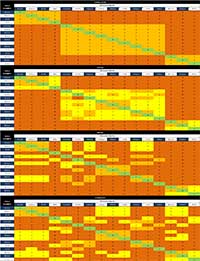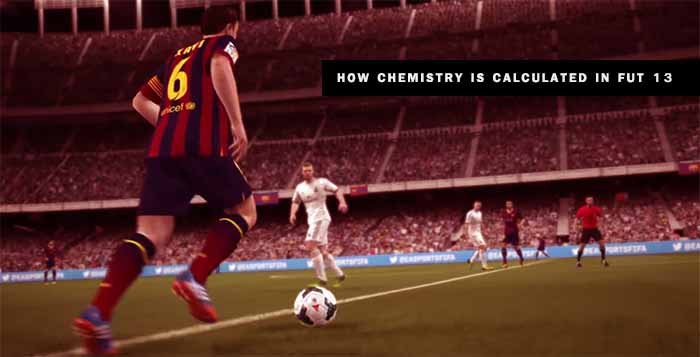The way how is calculated the chemistry in FIFA 13 Ultimate Team is probably the most well kept secret of the game. Not any more.
We already has published about it but now we have a method even simpler.
The InGame Chemistry in FIFA 13 Ultimate Team
In the first place it is important to know that the chemistry value that is used on the game is the weighted average of the individual chemistry (75%) and the squad’s chemistry (25%).
Unlike many people think, having individual chemistry values of 9 is much more important than having a value of 100 on the squad’s chemistry display.
Even because the individual chemistry doesn’t only weights three quarters of the chemistry utilized on the game, but it also affects directly the chemistry of the squad, as we’re going to see next.
In other words, you can say that the attributes that each player starts a match with depend directly on the individual chemistry and partially on the squad’s chemistry.
Squad’s Chemistry Calculation
The squad’s chemistry varies between 0 and 100 and can be calculated with the following formula:
SC = IC + MC
where
SC is the squad’s chemistry
IC is the players’ individual chemistry (to be seen further)
MC is the manager’s contribution for the chemistry.
This formula allows the team’s chemistry to exceed 100. Although, in practical terms, any value that is superior to 100 has the same effect as 100.
On the other hand, the value the manager contributes for the chemistry varies between 0 and 21 and is calculate this way:
MC = F x L + N
where
F = 0 if the manager’s preferred formation and the squad’s do not match
F = 1 if the manager’s preferred formation and the squad’s match
L = 2 if he’s a bronze manager
L = 5 if he’s a silver manager
L = 10 if he’s a gold manager
N is the number of the starting eleven that have the same nationality as the manager.
Individual Chemistry Calculation
The player’s individual chemistry calculation method is very complex. We tried to make it as simple as possible through a procedure with only five steps.
Before we begin, you should have in mind that in order to calculate a player’s individual chemistry you need to know:
- the squad’s formation
- the player’s preferred formation
- the player’s position
- the player’s preferred position
- how many links he has and which type
Being aware of these details, just follow these steps to discover a player’s individual chemistry value.
- Step 1
Find out the value F, which measures the familiarity of the player’s formation with the squad formation.
Use the table below to determine if F is equal to 3 (same formation), 2, 1 or 0.
This table indicates which formation a player likes to play with (green), if he can play adapted (orange) or if he plays with great difficulties (red). Just select the formation line that is recorded on the player card and look the formation column in which the player was assigned to play.
Notice that this table is divided in four sections: goalkeepers, defenders, midfielders and attackers. It is that way because the players adapt themselves better to other formations according to their position. For example, a defender with a 4-4-2 preferred formation adapts himself better in a 4-3-3 formation than an attacker because the new formations maintains the 4 defenders playing style but not the 2 attackers.
 F Value
F ValueIf you do not want to have to consult this table, you can also follow this rule that, in general, gives the same result:
Goalkeepers
F=3 if the player’s formation and the squad formation matches
F=2 if the player’s formation and the squad formation do not matches but they have both the same amount of defenders
F=0 if the player’s formation and the squad formation do not matches and they do not have the same amount of defenders
Defenders
F=3 if the player’s formation and the squad formation matches
F=2 if the player’s formation and the squad formation do not matches but they have both the same amount of defenders, midfielders and attackers
F=1 if the player’s formation and the squad formation do not matches, they have both the same amount of defenders but different amounts of midfielders and attackers
F=0 if the player’s formation and the squad formation do not matches and they do not have the same amount of defenders
Midfielders
F=3 if the player’s formation and the squad formation matches
F=2 if the player’s formation and the squad formation do not matches but they have both the same amount of defenders, midfielders and attackers
F=1 if the player’s formation and the squad formation do not matches, they have both the same amount of midfielders but different amounts of defenders and attackers
F=0 if the player’s formation and the squad formation do not matches and they do not have the same amount of midfielders
Attackers
F=3 if the player’s formation and the squad formation matches
F=2 if the player’s formation and the squad formation do not matches but they have both the same amount of defenders, midfielders and attackers
F=1 if the player’s formation and the squad formation do not matches, they have both the same amount of attackers but different amounts of defenders and midfielders
F=0 if the player’s formation and the squad formation do not matches and they do not have the same amount of attackers
- Step 2
- Step 3
- Step 4
- Step 5
Find out the value P, which measures the familiarity of the player with his position.
Use the table below to determine if P is equal to 3 (same position), 2, 1 or 0.
This table indicates in which position a player likes to play (green boot), if he can get adapted to another position (orange boot) or if he is playing with great difficulties (red boot). Just select the position line that is recorded on the player card and look at the position column in which the player was assigned to play.
 P value
P value
Find out the value PT, which measures the familiarity of the player with his position and formation.
Use the table below to determine if PT is equal to 6 (same position and same formation), 5, 4, 3, 2, 1 or 0.
You just need to use the F of the step 1 and the P of the step 2. The intersection of this row / column gives the value PT.
| POSITION [P] | ||||||
| 0 | 1 | 2 | 3 | |||
| FORMATION [F] | 0 | 0 | 1 | 2 | 3 | |
| 1 | 0 | 1 | 3 | 4 | ||
| 2 | 0 | 2 | 3 | 5 | ||
| 3 | 0 | 2 | 4 | 6 | ||
Find out the value L, which measures the links intensity of a player with his team mates.
The first thing to do is to add the points of each link in accordance with the following:
Same League but different Nationality and Club……..1.0 points
Same Nationality but different League………………….1.5 points
Same Club but different Nationality……………………..2.5 points
Same Nationality and League but different Club……..2.5 points
Same Nationality and Club………………………………….4.0 points
Divide the sum of these points by the number of links and you will get S that you will use in the following table to find out L:
| L | S |
| 0 | 0.00 to 0.49 |
| 1 | 0.49 to 0.99 |
| 3 | 1.00 to 1.99 |
| 5 | More than 1.99 |
Calculate the Individual Chemistry.
With practice, this entire procedure becomes very easy. For example: if you know that the player is in correct position and has correct formation, you can skip to step 4 and assume that PT = 6.
At last, we want to leave one tip for who likes to put players in their right position and formations and want to know that, in an expedited way, if certain links are enough to reach the 9 points of individual chemistry.
For any player to have the maximum chemistry he just need to have a number of points equal or superior to the number of connections he has with his team mates. These points are counted by what we explained in step 4.
This article is somewhat academic. It was published just to show how is calculated the chemistry in FUT 13. If you want to calculate it in an expeditious way, use our Chemistries calculators:
Individual Chemistry Calculator for FIFA 13 Ultimate Team
Squad Chemistry Calculator for FIFA 13 Ultimate Team
